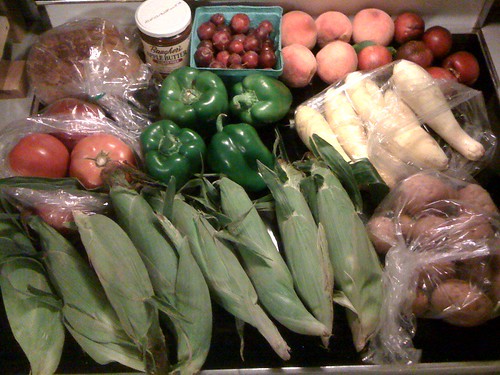Did you know that Breezy Willow also sells fresh, local meat? Depending on availability, Breezy Willow offers locally raised, grass fed beef, pork, chicken, and lamb. You can browse the selection at their
website, or
contact RJ to make a request. If you purchase through the website, we can deliver it to BBMS on Thursdays along with the regularly scheduled pickup. You can pay at that time and ignore the shipping fee. Here are two meals Katie and I have made recently using meat from Breezy Willow.
Orange Pork Chops
This recipe (and all preparation) was courtesy of Katie's Mom, Nanci, who was visiting us at the time.
I didn't know this until I looked it up, but a capital T stands for tablespoon, while a lower case t stands for teaspoon.4 center cut pork chops
salt, pepper, paprika
2 T. oil
10 whole cloves
2 T. grated orange rind
2 T. cornstarch
2 c. orange juice
1/2 c. sugar
2 t. cinnamon
1/4 t. salt
2 whole navel oranges, sliced thin for garnish
rice (prepare as directed)
Season pork chops on both sides with salt, pepper, and paprika. Brown chops in hot oil in skillet. Once they are browned, cover bottom of skillet with water (do not completely cover chops), turn down heat, and cover skillet. Simmer till tender, (about an hour or so), adding water as it cooks away. Turn chops as needed. Meanwhile, prepare orange sauce and rice.
Orange Sauce:
In a saucepan, cook sugar, cornstarch, salt, cinnamon, cloves, orange juice and rind. Cook over medium heat until thickened. (if it does not thicken enough, mix 1 more tablespoon cornstarrch with a little bit of water then stir into sauce) Transfer chops to serving platter. Pour sauce over chops and rice. Garnish with orange slices.
Ropa Vieja (Braised Beef, Peppers, and Onions)
This recipe came from
The Gourmet Cookbook, but can also be found online at
Epicurious.com.
p.s. Epicurious is an excellent resource for recipes!!Ingredients
For braising beef:
* 3 pounds skirt or flank steak, trimmed
(we used beef cubes from B.W.) * 2 quarts water
* 2 carrots, chopped coarse
* 1 large onion, chopped coarse
* 2 celery ribs, chopped coarse
* 1 bay leaf
* 3 garlic cloves, crushed lightly
* 1 teaspoon dried oregano
* 1 teaspoon ground cumin
* 1 teaspoon salt
* 1/4 teaspoon whole black peppercorns
we skipped the carrots and celery as we did not have them and they were only used for flavoring the stock. * 2 green bell peppers, cut into 1/4-inch strips
* 1 red onion, cut into 1/4-inch strips
* 4 tablespoons olive oil
* 2 cups braising liquid plus additional if desired
* a 14- to 16-ounce can whole tomatoes with juice, chopped
(we used Ro*tel) * 3 tablespoons tomato paste
* 3 garlic cloves, minced
* 1 teaspoon ground cumin
* 1/4 teaspoon dried oregano
* 2 red bell peppers, cut into 1/4 inch strips
* 2 yellow bell peppers, cut into 1/4 inch strips
* 1 cup peas
* 1/2 cup pimiento-stuffed Spanish olive, drained and halved
(we subbed green peppers for 1 red and 1 yellow as we had several from B.W.)Preparation
To braise beef:
In a 5-quart kettle combine all braising ingredients and simmer, uncovered, 1 1/2 hours, or until beef is tender. Remove kettle from heat and cool meat in liquid 30 minutes. Transfer meat to a platter and cover. Strain braising liquid through a colander, pressing on solids, into a bowl. Return braising liquid to kettle and boil until reduced to 3 cups, about 30 minutes. Stew may be made up to this point 1 day ahead. Cool braising liquid completely and chill it and the beef separately, covered.
In kettle cook green bell peppers and onion in 2 tablespoons oil over moderate heat, stirring, until softened.
While vegetables are cooking, pull meat into shreds about 3 by 1/2 inches. To onion mixture add shredded meat, 2 cups braising liquid, tomatoes with juice, tomato paste, garlic, cumin, oregano, and salt and pepper to taste and simmer, uncovered, 20 minutes.
While stew is simmering, in a large skillet cook red and yellow bell peppers in remaining 2 tablespoons oil over moderate heat, stirring occasionally, until softened. Stir peppers into stew with enough additional braising liquid to thin to desired consistency and simmer, uncovered, 5 minutes. Stir in peas and olives and simmer, uncovered, 5 minutes.
Serve ropa vieja with yellow rice.































